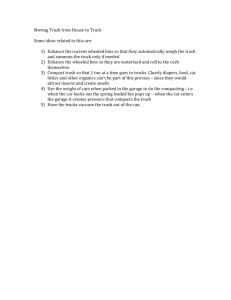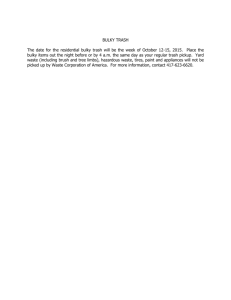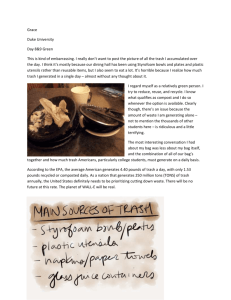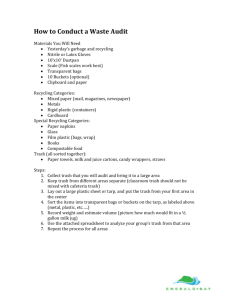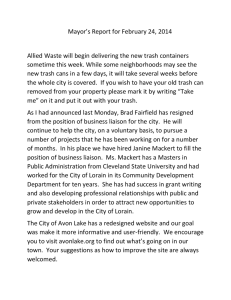Word - Green Ninja
advertisement
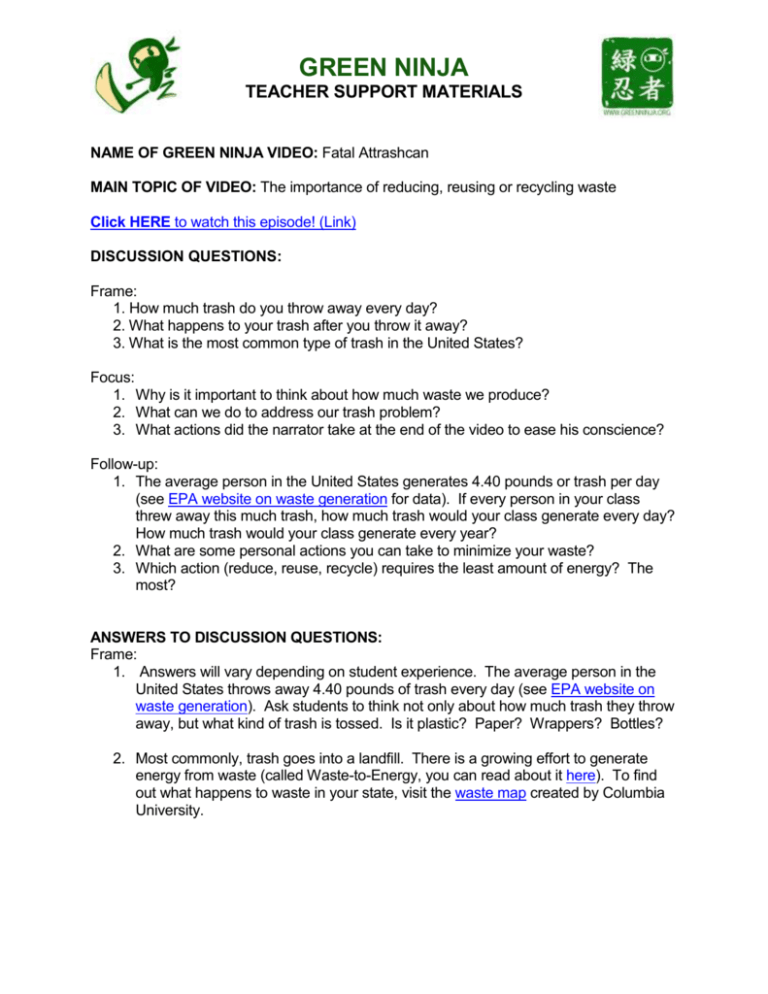
GREEN NINJA TEACHER SUPPORT MATERIALS NAME OF GREEN NINJA VIDEO: Fatal Attrashcan MAIN TOPIC OF VIDEO: The importance of reducing, reusing or recycling waste Click HERE to watch this episode! (Link) DISCUSSION QUESTIONS: Frame: 1. How much trash do you throw away every day? 2. What happens to your trash after you throw it away? 3. What is the most common type of trash in the United States? Focus: 1. Why is it important to think about how much waste we produce? 2. What can we do to address our trash problem? 3. What actions did the narrator take at the end of the video to ease his conscience? Follow-up: 1. The average person in the United States generates 4.40 pounds or trash per day (see EPA website on waste generation for data). If every person in your class threw away this much trash, how much trash would your class generate every day? How much trash would your class generate every year? 2. What are some personal actions you can take to minimize your waste? 3. Which action (reduce, reuse, recycle) requires the least amount of energy? The most? ANSWERS TO DISCUSSION QUESTIONS: Frame: 1. Answers will vary depending on student experience. The average person in the United States throws away 4.40 pounds of trash every day (see EPA website on waste generation). Ask students to think not only about how much trash they throw away, but what kind of trash is tossed. Is it plastic? Paper? Wrappers? Bottles? 2. Most commonly, trash goes into a landfill. There is a growing effort to generate energy from waste (called Waste-to-Energy, you can read about it here). To find out what happens to waste in your state, visit the waste map created by Columbia University. GREEN NINJA TEACHER SUPPORT MATERIALS 3. The biggest source of trash in the US is paper products, followed by food waste, yard trimmings and plastics. See the EPA website on municipal waste for more information. Focus: 1. As stated in the video, we have a finite amount of space on our planet. If we produce too much trash, we will run out of places to store it. 2. We can reduce, reuse or recycle our waste (the 3 R’s) 3. He started using a reusable water bottle and he recycled his sandwich container. Follow-up: 1. 𝑇𝑜𝑡𝑎𝑙 𝑇𝑟𝑎𝑠ℎ 𝐺𝑒𝑛𝑒𝑟𝑎𝑡𝑒𝑑 = (𝑡𝑜𝑡𝑎𝑙 𝑛𝑢𝑚𝑏𝑒𝑟 𝑜𝑓 𝑠𝑡𝑢𝑑𝑒𝑛𝑡𝑠) × 4.40 𝑙𝑏𝑠. 𝑇𝑜𝑡𝑎𝑙 𝑇𝑟𝑎𝑠ℎ 𝐺𝑒𝑛𝑒𝑟𝑎𝑡𝑒𝑑 𝑃𝑒𝑟 𝑌𝑒𝑎𝑟 = 𝑇𝑜𝑡𝑎𝑙 𝑇𝑟𝑎𝑠ℎ 𝑃𝑟𝑜𝑑𝑢𝑐𝑒𝑑 × 365 𝑑𝑎𝑦𝑠 For a class of 28 students, the total trash generated per day would be 123.2 lbs. For a class of 28 students, the total trash generated per year would be 44,968 lbs. 2. Answers will vary. Some ideas might include: using a reusable water bottle, using reusable bags for sandwiches and snacks, recycling, reusing waste for other purposes (for example, using a food jar to store crayons). 3. Reduce < Reuse < Recycle. To reduce the amount of trash we generate is the most energy efficient because we are not buying a product in the first place (it takes energy to produce a good). To reuse would be the next best option, because even though we are consuming a product that took energy to make, we are not throwing it away. By doing this, we take product out of the waste stream after manufacture. To recycle is the third best option in terms of energy needed because energy was needed to manufacture the product and is also needed to recycle the product. ADDITIONAL TOPICS AND LEARNING EXPERIENCES: Students should begin to think about the alternative uses of their trash. To start, ask students to collect the trash they produce for one day and use it to create a piece of art work. Here is a summary of a few artists who work with recycled materials. GREEN NINJA TEACHER SUPPORT MATERIALS Teach students about the difference between recycling and upcycling. Ask students to brainstorm ways that they can upcycle the trash they generate in a day. They can get ideas from upcycling magazine about how to upcycle their waste. The EPA has developed several websites that are devoted to learners and teachers concerned with waste. Visit these websites for more ways to help the planet. The growing use of electronic devices has led to an increase in what is known as “Ewaste”. Ask students to research how their E-waste should be disposed of. Where should we dispose of cell phones, old printers, TVs or any other electronic device? The City of San Jose has a website that can point citizens in the right direction. ADDITIONAL NOTES AND RESOURCES: The EPA has a Reduce, Reuse and Recycle webpage with handy tips and facts. November 15 is “America Recycles Day”. It’s important to reduce, reuse or recycle our waste. One family in the bay area has committed to producing only a single bag of trash a year for their whole family! You can learn about the steps they’ve taken to practice the 3 R’s on their website: The Zero Waste Home For additional teaching curriculum related to waste, Facing the Future has produced a two week unit on how goods are produced, distributed and discarded. This unit tackles the environmental and social justice issues surrounding consumption: Buy, Use and Toss Curriculum This series of videos from BBA News documents the variation in waste disposal from four different countries (United States, Italy, Belgium, South Korea) Many artists have reused materials in mixed media pieces. For an example of art created with discarded items and focused on issues of consumption and waste, see the work of Chris Jordan. Miguel Rivera creates art from discarded electronic waste. See examples of his work and an article about him here. Scientific research has been done on the fate of trash after it lands in a trash can. Visit this MIT webpage for research, videos and resources on trash in our cities. The state of California maintains a website with more information on the toxicity and regulations surrounding E-Waste. Credit: This teacher resource has been adapted from content originally developed by Lee Pruett.

